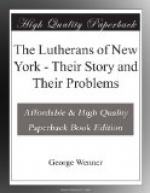The Houston Street party in 1839 held hierarchical views. Subsequently they adopted the congregational theory of the church and established in 1843 the first “Missouri” congregation in New York under Pastor Brohm. After several removals the congregation settled at Ninth Street and Avenue B, where it still maintains its place of worship.
The chief field of the “Missourians,” as their name indicates, is in the West. And yet in Greater New York they number 51 churches and many more in the suburbs. They maintain numerous missions among special classes. At Bronxville they have a college. They alone of all Lutherans make a serious effort to conduct parochial schools. More than any other variety of Lutherans do they educate their promising young men for the ministry.
But, as has already been intimated, the chief significance of their entrance into New York history is that thenceforth Lutherans had to give an account of their Lutheranism. Whether you agreed with them or not, you had to take sides and give a reason for the hope that was in you. They brought about that “contiguity of conflicting opinions” which is a condition of all progress.
Ten years later a different class of German immigrants came to our city. The Revolution of 1848 had resulted unsuccessfully for the friends of political freedom, and many were compelled to take refuge in America. Some were professional men of ability and high standing, whose contribution to the intellectual life of our city was considerable. Others were only half educated, young men who had not completed their studies in the University, but, intoxicated with the new ideas, had thrown themselves with the enthusiasm of youth into the conflict for freedom. Here they were like men without a country, aliens from the Fatherland, and in America incapable of comprehending a state without a church and a church without a state.
Few of these found their way into the Lutheran churches of New York. They were the intellectuals of the German community and had outgrown the religion of their countrymen who still adhered to the old faith.
Our churches received but little support from this large and influential class. Many of them had long since renounced allegiance to Jesus, and in the free air of America looked upon churches as anachronisms and hearthstones of superstition. Their influence upon the common people and upon the social life of the German community was hostile to that of Christianity. The churches had to get along without them, or rather, in spite of them. There were notable exceptions. But as a rule the “Achtundvierziger” did not go to church.
Still, in spite of their unchurchly views, most of them were unable to shake off wholly the forms of their ancestral religion. There were too many remnants (superstites) of the old faith binding them to ancient customs. Independent ministers with no synodical relations, with or without certificate of ordination, or the endorsement of organized congregations, unmindful of the nisi vocatus clause in the Augsburg Confession, helped to maintain the forms of an inherited Christianity by performing such ministerial acts as were required by the people. At one time these free lances were quite numerous. At present no representatives survive in New York.




